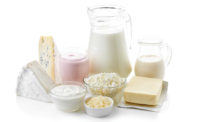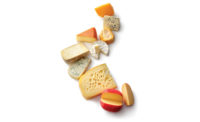The dairy industry currently faces a number of challenges ranging from global trade obstacles to the rise of plant-based dairy alternatives. Dairy Foods asked the top executives from leading dairy associations to provide their thoughts related to current industry issues and opportunities — and to discuss how their organizations are helping members succeed in trying times.
Participants include Blake Anderson, CEO of the American Dairy Products Institute (ADPI); Michael Dykes, president and CEO of the International Dairy Foods Association (IDFA); Brad Legreid, executive director of the Wisconsin Dairy Products Association (WDPA); John Umhoefer, executive director of the Wisconsin Cheese Makers Association (WCMA); and Tom Vilsack, president and CEO of the U.S. Dairy Export Council (USDEC).
Dairy Foods: What are your members most worried about right now, and why?
Blake Anderson: We have a diverse group of members, including producers, processors, sellers/marketers, distributors and service providers to our industry. There are two overarching concerns given the times we are in. Those are: 1) economic viability of the U.S. dairy supply chain (cow to consumer) given cost to produce and negative margins returned on products sold (related to low prices); and 2) geopolitical impacts on our ability to supply and export products on a level playing field beyond U.S. borders — i.e., global trade.
Global trade and the ability to have fair and equitable access to foreign markets for our dairy products/ingredients is a key to survival for our membership. We’ve witnessed hundreds of dairies close or shut down across the U.S. after decades of operating, due to the current economic climate and disruptions. Consumers and everyone linked to them all suffer in trade wars.
Michael Dykes: The dairy industry understands the importance of innovation and expanding choice to adapt to a changing consumer marketplace. For that to happen, our members need the ability to launch new products and grow the market with fewer burdens — a level playing field for trade, reforming the outmoded milk price regulation system, building a stable workforce and limiting the impacts of industry consolidation. I’d add sustainability concerns to this list — not only ensuring good environmental stewardship, but standing for and enforcing the highest animal welfare and product sourcing standards across the industry.
Helping consumers recognize again that dairy is wholesome and nutritious is a challenge because we’ve experienced a few decades of confusing and contradictory nutritional recommendations on dairy. We think the dust has settled on this, and the research is more and more clear that dairy — all fractions of the bucket of milk — contributes to a healthy life and offers huge benefits for child health.
All these issues are important for our members as we look to the long-term viability and growth of the dairy industry in the United States.
Brad Legreid: Members of the Wisconsin Dairy Products Assn. deal with myriad concerns on an annual basis. These worries focus on milk prices and supply, labor needs, trade wars and domestic and foreign competition.
However, every year, I continually hear their frustrations about the federal and state regulations which thwart their competitive abilities. Whether it’s due to overregulation, an abundance of plant inspections resulting from a disjointed USDA/state inspection system, or the [in]ability for regulators to stay abreast of the latest manufacturing technologies, these all result in placing a stranglehold over processors’ abilities to compete.
John Umhoefer: Some worries are unique to the size of our processor members, but across the spectrum, we hear that finding and retaining great employees is an enormous challenge. Producing dairy products is real work, and beyond just the physicality of many roles, making consistent, quality dairy products requires experience and training.
Cheesemaking, as one example, is described as an art as much as a science, and our manufacturers are working to transfer priceless institutional knowledge from a retiring corps of baby boomers to the next generation who will make great cheeses.
Tom Vilsack: We are all deeply concerned about the overall state of the global economy tending toward a recession, fueled in part by the trade war with China and uncertainty over the United Kingdom’s exit from the European Union. It is imperative that we maintain and improve access to foreign markets.
U.S. suppliers are severely disadvantaged when they face higher tariffs than their EU or New Zealand counterparts in key growth markets like Japan or retaliatory tariffs in markets like China. And they cannot compete when unfair non-tariff barriers restrict access, as they repeatedly threaten to do in countries all over the world.
Schemes like the EU’s geographical indications policy that seeks to monopolize common cheese names or baseless attempts to revise food standards through the Codex Alimentarius Commission are ongoing threats to U.S. export success.
Dairy Foods: What is your organization doing to help address these member concerns?
Anderson: We at ADPI work with and across our membership to ensure they have the best information, training and education to be able to innovate, develop new products and processes, and ensure that their products and services are second to none from a quality, security and safety perspective. We are constantly engaged in seminars, conferences, webinars, training academies and industry forums on a pre-competitive basis to enable the best minds of our industry to meet, network and develop proactive solutions to the challenges they all face.
We also work with and across other trade associations and our government officials on similarly faced issues to ensure we marshal the collective expertise of our industry.
Dykes: Given IDFA’s broad membership across the entire dairy industry, we’re working on behalf of our members with a unified voice to advocate for policies that lead to economic growth, innovation and access to nutritional products for all consumers. Our staff is working with other dairy organizations on practical and feasible updates to the Federal Milk Marketing Orders. We have been proactive in pressing the current administration on the necessity of a comprehensive rules-based system of international trade that will level the playing field and expand market access for the U.S. dairy industry. For us, passage of the United States-Mexico-Canada Agreement is a necessity, as well as finalizing bilateral agreements with Japan and China that remove unfair barriers to trade.
On the nutritional front, we’d like to see the Child Nutritional Reauthorization restore low-fat 1% flavored milk in schools and offer reduced-fat 2% to WIC participants. There is an overwhelming body of research recognizing dairy as part of a healthy diet — we need our policymakers to recognize it.
We will work hard to maintain the current recommendations for dairy in the next version of the Dietary Guidelines for Americans. Our team is also working to get federal funding for a SNAP incentive program for fluid milk and dairy products.
Along with MilkPEP and Feeding America, we’re working with USDA on continuing the successful fluid milk purchase program for food banks. And finally, IDFA’s NextGen Leadership program aims to prepare tomorrow’s leaders to carry the industry into the future.
Legreid: Our association has a long history of making concerted efforts to reduce burdensome regulatory activity. A number of years ago, we worked with USDA and the Wisconsin Department of Agriculture, Trade and Consumer Protection on a pilot program for shared inspection services. In addition, our association is the only one in our state that meets with our state regulators prior to every National Conference on Interstate Milk Shipments to ensure congruency between state and federal regulations.
We also invite state regulators to our board of directors meeting on a regular basis so they can address key regulations and hear from our directors on how their companies will be impacted by these regulations.
Umhoefer: Training — both in the technical aspects of food safety and dairy production, as well as effective management — has leapt to the top of our priorities. Wisconsin has such great assets in Center for Dairy Research at the University of Wisconsin, Dairy Farmers of America and our state regulators.
WCMA has built leadership and communications training for frontline and higher-level managers, and collaborated with our state partners to offer in-depth educational opportunities like the 10-week live online Certificate in Dairy Processing. To the industry’s credit, these opportunities are selling out as fast as we can offer them.
Vilsack: USDEC’s efforts are wide-ranging and aggressive. We provide constant input and guidance to the U.S. government during trade negotiations to make sure agreements account for U.S. dairy interests. We form partnerships with international organizations like the Inter-American Institute for Cooperation on Agriculture to promote science-based regulations and policies affecting food and
ag trade.
We proactively engage in Codex standard-setting processes to defend science and advance key dairy standards. We work directly with the U.S. and foreign governments to prevent the imposition of undue regulatory burdens. And we continue to seek out untapped opportunities and expand the U.S. dairy presence in high-potential markets. The list goes on.
Dairy Foods: Looking ahead to 2020, what do you see as the most significant opportunities for your members (or dairy processors overall), and what will they need to be able to tap into those opportunities?
Anderson: Without change, there are no opportunities. Change is often the result of challenges faced. We cannot afford to maintain the “status quo,” as it no longer exists, in the dairy business.
The most significant opportunities for our members are related to: 1) ensuring consumers understand the inherent goodness and superiority of dairy products and ingredients as compared to the “alternatives” that have and are continuing to emerge; 2) re-establishing our global trade/export capabilities to be able to sell our goods and services beyond U.S. borders, thus providing stability and economic benefit to our dairy producers and processors and related supply chain stakeholders; and 3) proactive, positive and impactful marketing of U.S. dairy products and ingredients, in and to domestic and international markets, in order to establish and maintain a solid point of difference vs. the rest of the world.
Dykes: Again, when we look to the future, we’re looking to meet changing consumer preferences. As consumers place a premium on protein in their diet, the dairy industry will be there to offer new options that meet health and wellness demands.
IDFA is working to ensure dairy products get back in the “health foods category.” To deliver on these new demands, the dairy industry needs supportive policy.
Earlier this year we restructured our governance to create one streamlined IDFA that represents and engages all segments of the growing dairy industry. A major part of the new governance model are five industry segment boards representing fluid milk, yogurt and cultured products, ice cream, cheese, and dairy-derived ingredients.
We are seeking a combination of smart policy updates, as well as safeguarding and funding existing policies in eight common priority areas: nutrition, research, education, standards, food safety, trade, labor and Federal Milk Marketing Orders. We’re also seeking to define in federal law the term “natural cheese” — a process for cheesemaking distinguished from processed cheese — to help prevent consumer confusion.
Legreid: Two significant developments which should arise in 2020 pertain to trade agreements and dairy product labeling. With so much riding on next November’s elections, chances are likely that key trade battles and agreements will be resolved prior to that time to enhance President Trump’s political/public image. Resolution of any trade agreements will be a win for dairy processors, especially those companies who are poised and ready to jump back into world trade.
Next year should also bring a decision by FDA on whether plant-based products can be labeled as dairy. The agency’s decision may initially focus on fluid milk, but this labeling debate will certainly envelop all dairy products.
There will likely be a flurry of activity in state legislatures to pass legislation restricting the use of “dairy” for plant-based products (Wisconsin has just introduced such legislation). This type of state legislation will put additional pressure on FDA to resolve the labeling debate.
Dairy manufacturers need to be prepared to take advantage of new marketing opportunities which could arise if there’s a favorable FDA decision.
Umhoefer: Dairy’s opportunity lies in marketing, marketing, marketing. Many of the best cheeses, butters and high-tech dairy ingredients in the world are made here in the U.S. We have a story to tell about quality, clean ingredients and real nutrition, but we need memorable brands, better packaging and focused messages to reach today’s consumer.
Every newcomer from pea protein to gummed almond paste “cheese” is vying for a piece of dairy’s dominant space. Dairy’s opportunity is to win consumer sales with the delicious flavor and nutrition we already have.
Vilsack: There are many reasons for optimism in 2020 and beyond. The interim U.S.-Japan trade agreement will improve access for U.S. dairy to a large and growing market. Congressional approval of the U.S.-Mexico-Canada Agreement will strengthen the critical trade relationship that the U.S. shares with Mexico while opening new opportunities for U.S. dairy in Canada.
A series of USDEC partnerships and programs will elevate U.S. Dairy’s presence overseas, help build demand and support U.S. supplier export efforts — everything from the opening of USDEC’s first-of-its-kind U.S. Center for Dairy Excellence in Singapore to new Costco partnerships in China and Mexico to the official rollout of the USA Cheese Guild aimed at building a global community of U.S. cheese advocates and users.
To learn more about these dairy organizations and stay apprised of their news and events, visit their websites:
ADPI: www.adpi.org
IDFA: www.idfa.org
USDEC: www.usdec.org
WCMA: www.wischeesemakersassn.org
WDPA: www.wdpa.net




